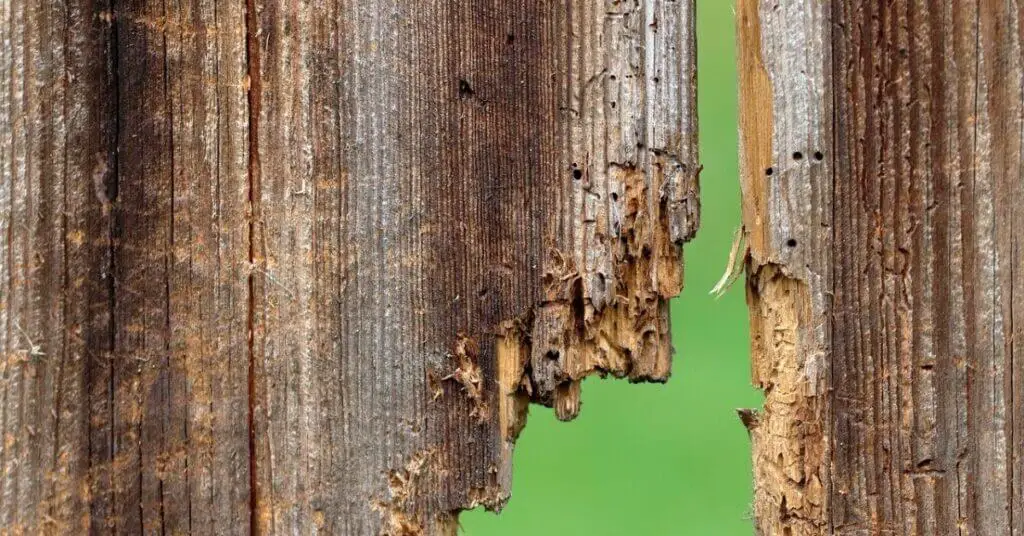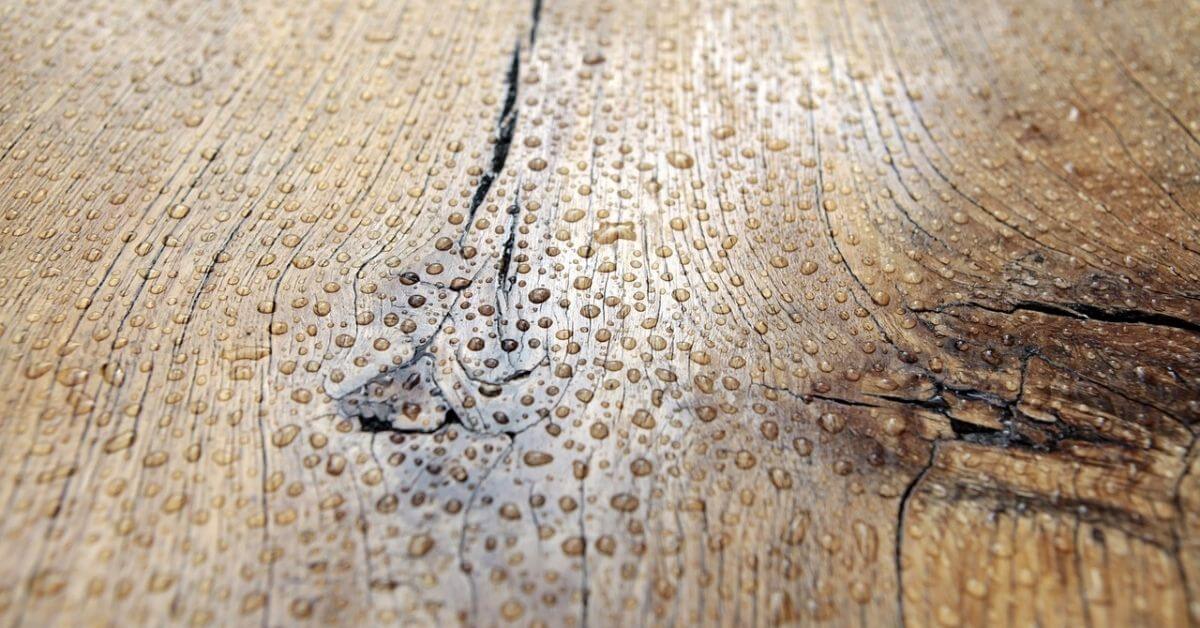Rainy weather can be a problem for your outdoor furniture. Some species of wood absorb moisture and start rotting. In such a situation, it is necessary to choose the right wood for outdoor application.
We know that no wood species is 100% waterproof. Just some wood species and treated wood perform well in rainy weather. Wood treatment is a process that enhances the wood properties without losing its own characteristics.
Once the wood starts deteriorating, it spreads very fast. In such a situation, it is better to quickly remove the rotten part of the wood.
Here are some Top waterproof wood species that are naturally rot-resistant and suitable for the rainy season.

1. Black Locust (Robinia pseudoacacia)
Black Locust is a tree family of legumes (Fabaceae). It is native to the Central-eastern United States and known for great decay resistance, with good weathering characteristics.
The Shrinkage value of Black Locust is Radial: 4.6%, Tangential: 7.2%, Volumetric: 10.2%, T/R Ratio: 1.6. Which is very great for marine applications. Many boat makers use it to make boats and boat parts.
| # | Black Locust |
| Average Dried Weight: | 48 lbs/ft3 (770 kg/m3) |
| Janka Hardness: | 1,700 lbf (7,560 N) |
| Crushing Strength: | 10,200 lbf/in2 (70.3 MPa) |
| Color/Appearance: | Pale greenish-yellow to a darker brown. Color tends to darken with age |
| Grain/Texture: | Grain is usually straight, with a medium texture. |
| Workability: | Overall working characteristics are good |
| Uses: | Fence posts, boat building, flooring, furniture, mine timbers, railroad ties, turned objects, and veneer. |
2. Teak (Tectona grandis)
Teak is a hardwood tree species in the family Lamiaceae, native to southern Asia. It has naturally decay properties and its heartwood is rated as very durable. Teak is also resistant to termites and insects.
There are many species of teak such as – Burma teak (very famous and the real teak wood ), Asian teak wood, Indonesian teak wood, Chinese teak wood, African teak wood, Golden teak wood, South American teak wood, and many more.
| # | Teak (Tectona grandis) |
| Average Dried Weight: | 41 lbs/ft3 (655 kg/m3) |
| Janka Hardness: | 1,070 lbf (4,740 N) |
| Crushing Strength: | 7,940 lbf/in2 (54.8 MPa) |
| Color/Appearance: | Heartwood is golden or medium brown, Color tends to darken with age. |
| Grain/Texture: | The grain is straight, sometimes there is interlocked grain. |
| Workability: | The overall workability is good but can be a bit difficult due to the presence of resin. |
| Uses: | Boat Building, exterior construction, veneer, furniture, carving, turnings, and other small wood projects |
3. Redwood(Sequoia sempervirens)
Redwood is native to the Coastal northwestern United States. It is also known as Sequoia, Coast Redwood, California Redwood, Vavona (burl).
Redwood has unique characteristics. Redwood furniture has great durability along with a great appearance.
| # | Redwood(Sequoia sempervirens) |
| Average Dried Weight: | 26 lbs/ft3 (415 kg/m3) |
| Janka Hardness: | 450 lbf (2,000 N) |
| Crushing Strength: | 5,690 lbf/in2 (39.2 MPa) |
| Color/Appearance: | Heartwood color is light pinkish brown to a deep reddish-brown and Sapwood is a pale white/yellow. |
| Grain/Texture: | Grain is generally straight, though figured pieces may be wavy or irregular. |
| Workability: | Easy to work with hand tools or machinery |
| Uses: | Beams, posts, decking, exterior furniture, and trim |
4. Cypress (Taxodium distichum)
Cypress is a deciduous conifer in the family Cupressaceae and native to the Southeastern United States. Common names include bald cypress, swamp cypress, white cypress, tidewater red cypress, gulf cypress, and red cypress.
Cypress does not have great hardness and density. Also, it is not rated as decay resistance. but Old-growth Cypress is rated as being durable to very durable in regards to decay resistance
| # | Cypress(Taxodium distichum) |
| Average Dried Weight: | 32 lbs/ft3 (515 kg/m3) |
| Janka Hardness: | 510 lbf (2,270 N) |
| Crushing Strength: | 6,360 lbf/in2 (43.9 MPa) |
| Color/Appearance: | Heartwood is yellowish-brown and the sapwood is nearly white. |
| Grain/Texture: | Straight grain and medium texture to coarse texture |
| Workability: | Cypress has good gluing, nailing, finishing, and paint-holding properties. |
| Uses: | Exterior construction, docks, boatbuilding, interior trim, and veneer |
5. Ipe (Tabebuia spp.)
Ipe is a genus of flowering plants in the family Bignoniaceae, native to Central and South America. It is also known as Epay and Brazilian Walnut.
Ipe is used as an ornamental tree for parks and residential areas. But it is very durable, excellent insect resistance. Therefore It is a great option for external use.
| # | Ipe (Tabebuia spp.) |
| Average Dried Weight: | 69 lbs/ft3 (1,100 kg/m3) |
| Janka Hardness: | 3,510 lbf (15,620 N) |
| Crushing Strength: | 13,600 lbf/in2 (93.8 MPa) |
| Color/Appearance: | Heartwood is reddish-brown, to a more yellowish olive brown, and sometimes darker brown/black stripes |
| Grain/Texture: | Straight grain with a medium texture. Moderate natural luster. |
| Workability: | Overall, Ipe is a difficult wood to work Due to the high Janka Hardness. |
| Uses: | Flooring, decking, exterior lumber, veneer, tool handles, and other turned objects. |
6. Cedar (Western Red)
Western Red Cedar is also known as Pacific red cedar, giant arborvitae or western arborvitae, or just cedar. This cedar is the most popular species among all species of cedar. Western red cedar is native to western North America.
It is famous for Shingles and Exterior siding. Even though it doesn’t have much hardness and density. Western Redcedar has been rated as durable to very durable in regard to decay resistance. Perform well for outdoor applications.
Read also Port Orford Cedar vs Western Red Cedar
| # | Cedar (Western Red) |
| Average Dried Weight: | 23 lbs/ft3 (370 kg/m3) |
| Janka Hardness: | 350 lbf (1,560 N) |
| Crushing Strength: | 4,560 lbf/in2 (31.4 MPa) |
| Color/Appearance: | Heartwood is reddish to pinkish brown and sapwood is pale yellowish-white. |
| Grain/Texture: | straight grain with medium to coarse texture |
| Workability: | Easy to work with both hand or machine tools |
| Uses: | Shingles, exterior siding and lumber, boatbuilding, boxes, crates, and musical instruments. |
7. Black Walnut(Juglans nigra)
Black Walnut is native to North America. It is widely used in the United States. Black walnut is hard, heavy, and resilient, capable of resisting warping. It is a very popular and widely available species.
Black Walnut is decay-resistant but it is susceptible to insect attack. It does not absorb moisture quickly. So it may be a great option for rainy weather.
| # | Black Walnut(Juglans nigra) |
| Average Dried Weight: | 38 lbs/ft3 (610 kg/m3) |
| Janka Hardness: | 1,010 LBF (4,490 N) |
| Crushing Strength: | 7,580 LBF/in2 (52.3 MPa) |
| Color/Appearance: | lighter pale brown to a dark chocolate brown with darker brown streaks |
| Grain/Texture: | Straight Grain, but can be irregular. |
| Workability: | Typically easy to work and Glues, stains, and finishes well. Responds well to steam bending. |
| Uses: | Furniture, cabinetry, gunstocks, interior paneling, veneer, turned items, and other small wooden objects |
8. Honduran Mahogany(Swietenia Macrophylla)
Honduran Mahogany is native to Mexico to central South America. Its extreme density and hardness make it suitable for marine applications. It is one of the most rot-resistant wood species and is known for its great strength, stability, durability, and rich dark brown color.
Mahogany is an expensive wood species. This is a rare wood species that is listed in the IUCN Red List. Because of the mahogany population reduction of over 20% in the past three generations.
| # | Mahogany(Juglans nigra) |
| Average Dried Weight: | 37 lbs/ft3 (590 kg/m3) |
| Janka Hardness: | 900 lbf (4,020 N) |
| Crushing Strength: | 6,760 lbf/in2 (46.6 MPa) |
| Color/Appearance: | Pale pinkish-brown, to a darker reddish-brown. Color tends to darken with age |
| Grain/Texture: | Grain can be straight, interlocked, irregular, or wavy. |
| Workability: | Typically easy to work and Glues, stains, and finishes well. |
| Uses: | Furniture, cabinetry, turned objects, veneers, musical instruments, boatbuilding, and carving. |
9. White Oak (Quercus alba)
White Oak is native to eastern and central North America. Oak is a favorite wood of boat makers. Because It is Rated as very durable, decay-resistant, and low maintenance. frequently used in boatbuilding and tight cooperation applications.
Read also Red Oak vs White Oak
| # | White Oak(Quercus alba) |
| Average Dried Weight: | 47 lbs/ft3 (755 kg/m3) |
| Janka Hardness: | 1,350 lbf (5,990 N) |
| Crushing Strength: | 7,370 lbf/in2 (50.8 MPa) |
| Color/Appearance: | Heartwood is a light to medium brown |
| Grain/Texture: | The grain is straight, with a coarse, uneven texture. |
| Workability: | Good workability with hand and machine tools |
| Uses: | Cabinetry, furniture, interior trim, flooring, boatbuilding, barrels, and veneer. |
Why does the wood start rotting in rainy weather?
Moisture
A normal wood contains about 20-30% moisture, more than that is not good for the wood and your pocket. So try to keep outdoor furniture away from moisture.
Oxygen
Where there is moisture there must be oxygen. Fungi grow well in the presence of oxygen and moisture. Which can damage any wood.
Not Regular Maintenance
Regular maintenance is very important for all outdoor furniture. It not only makes your furniture attractive but also doubles the lifespan.
Some species of wood have open grain pores and close grain pores. Which is responsible for absorbing moisture. Paints and polishes can close the open grain pores, which reduces the effect of moisture on the wood.
Wrong Choice of Wood Species
Not all types of wood can be used for all. Many times we make the wrong choice of wood and regret it later. So Before choosing wood for your project, take the opinion of the constructor.

